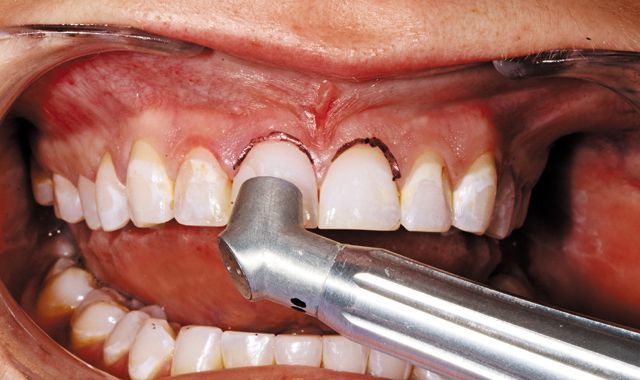3 cases showing the breakthrough of laser dentistry
The use of lasers in dentistry today has evolved from its beginnings in 1960.

The use of lasers in dentistry today has evolved from its beginnings in 1960.
In that year, Theodore H. Maiman, using a theory originally postulated by Einstein, created a device where a ruby crystal medium was stimulated by energy, and radiant, laser light was emitted from the crystal. In other words, he developed the first laser and called it Maser.
The search for a laser system with broader applications in dentistry led Dr. Terry Meyers and his brother William, an ophthalmologist, to select the Nd: YAG laser for experiments on the removal of incipient caries. Soon after, they began developing the first true dental laser system, which, according to textbooks and published literature, sparked the dental laser revolution and the first widespread exposure of lasers to dentistry.
In May 1991, the FDA granted a marketing clearance to American Dental Laser for soft-tissue uses. Awareness surged forward, and there were several major research projects underway using newer wavelengths in the experimental cutting of enamel and dentin. A valuable concept developed by Miserendino and Pick was that laser energy could create analgesia in a tooth because the natural waveguides in tooth structure could deliver energy to the pulpal that would decrease perceived pain in the C-afferent fibers.
The 1990s saw birth of erbium that had an absorption affinity to water and hydroxyapatite, as well as, somewhat, to melanin. By May 1997, Premier Laser obtained the first marketing clearance from the FDA to cut enamel and dentin in adults using an Er: YAG laser, a device readily available in dermatology and plastic surgery. In 1998, after more than 10 years of research and investigation, BIOLASE obtained a marketing clearance for an Er: YSGG device to allow cutting hard tissue in adults with a similar clearance for children soon thereafter (1999). There were further breakthroughs in laser endodontics (2002), apicoectomy (2002), cutting and shaving oral osseous tissues (2003), as well as the most complete list of procedures related to periodontal therapy, including laser curettage and osseous crown lengthening (2004). Other laser companies have managed to obtain a few of these same clearances later.
On-demand webinar: Understanding dental laser wavelengths and how they affect procedures
Despite these gains in treating multiple tissue substrates, the erbium laser was not optimally absorbed by enamel and dentin. As a result, cutting on tooth structure was slower than desired in terms of efficiency (cutting speed) and pulpal comfort perceived by patients. Fortunately, in the early 2000s, researchers led by Daniel Fried and John Featherstone at the University of California San Francisco ultimately found a 9.3-μm wavelength CO2 laser system (unlike the previous 9.6-μm and 10.6-μm settings) that more optimally utilized low energy laser pulses (1-5 mJ /pulse) delivered at a high repetition rate (400-Hz) would be more feasible for removing dental hard tissues with minimal peripheral thermal damage to enamel, dentin and pulpal tissues.
With that technological breakthrough, dentists now have a more reliable method to perform minimally invasive care, utilizing the ability of this unique wavelength to safely, effectively, quickly and comfortably perform caries removal, cavity preparation and intraoral soft-tissue surgery with reduced need for conventional drills to complete the procedures6. At this time, the only 9.3-μm wavelength CO2 laser to have FDA approval for these applications is the Solea laser (manufactured by Convergent Dental).
Related reading: Dental laser market projected to almost double in the next few years
Benefits of the 9.3-μm wavelength CO2 laser
The newest development in laser restorative care raises the bar on more conservative and needle-free dentistry for multiple reasons:
- The new, unique CO2 9.3 μm wavelength (cleared by the FDA for hard, soft and osseous tissue use) is highly absorbed by hydroxyapatite, which vaporizes enamel, giving you the power to work anywhere in the oral cavity with speed and ease.
- The Solea cuts soft tissue like native CO2 (10.6 μm) very cleanly and with less hemorrhage and discomfort during and after the procedure.
- This system has computer-controlled advanced technology utilizing galvo-optimized cutting patterns for the laser and a variable speed foot pedal that facilitates control similar to the intuitive handpiece. The integration of this computer-aided preparation (CAP) system enables the variable spot sizes (width control) and variable speed foot pedal (allows cutting and relaxation of tissue).
More on lasers: 5 things you need to know about laser dentistry
The future
The evolution of lasers in the last 40 years has made patient care more comfortable and less invasive, which makes dental care more attractive to the public. The 9.3-μm CO2 dental laser is the greatest advancement in this arena. Future updates in the technology with periodontal pocket care, closed flap gum lifts and root canal therapy are certainly forthcoming. This will allow the Solea to be a bigger asset in patient care for general dentists and specialists.
In addition to the improved criteria for prevention and risk assessment, creating even more minimally invasive methods of preserving natural enamel and creating an anti-aging theme in contemporary dental care, utilizing laser care is a desirable modality for removing diseased or undesirable tissue. The evidence-based findings of the past, in addition to advances in know-how and materials, have built a brighter future for our profession.
Watch a video of three different laser dentistry cases below:
About the author
Dr. Hugh Flax is known for his leadership in cosmetic dentistry. A past president of the American Academy of Cosmetic Dentistry, he has lectured and authored in Europe, Japan, Canada and the United States on lasers, smile design and advanced restorative techniques to enhance the skills of dental teams in making their care world-class.
Webinar: How all-tissue lasers enhance the traditional dental model